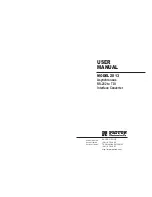
cases, most of the packets arrive in a mely manner, but a small percentage of them may be extremely late. It is
usually preferable to allow these late packets to be le out of the stream en rely and keep the delay lower. The
decoder error concealment hides these packet losses. The
Loss Cushion
parameter instructs the bu
ff
er manager
to ignore a certain percentage of late packets in its calcula on. The default value is 5%. Applica ons that are not
delay-sensi ve may wish to reduce this value to zero, while extremely delay-sensi ve applica ons may prefer to
have this closer to 25%.
Retransmit Squelch Trigger
- Retransmit Squelch op ons are used to determine how the bu
ff
er manager reacts
to typical data dropouts like those seen on wireless networks. The Trigger op on determines the amount of me
the decoder must experience 100% packet loss before the Retransmit Squelch func on is triggered. Default is one
second.
Retransmit Squelch Max
- The longest period of data loss during which the squelch func on is ac ve. Default is two
seconds. During the squelch period, the bu
ff
er manager ignores the rela ve ji er experienced and does not adjust
bu
ff
er size to compensate.
Fixed Delay
- This op on simply sets the
Delay Cushion
and
Delay Limit
at a similar value, so that the delay bu
ff
er is
de
fi
ned to the chosen value and will not increase or decrease signi
fi
cantly.
Delay Cushion
- The ji er bu
ff
er manager works to keep absolute delay to a minimum. Some applica ons are not
delay sensi ve and rely less on the ji er bu
ff
er manager. The
Delay Cushion
se ng is a way to instruct the manager
not to a empt to drive the delay below a certain value. For example, if the delay cushion is set to 500 ms, this
amount of
fi
xed delay will be added to the bu
ff
er. If the ji er manager needs to increase the bu
ff
er it will do so, but
will not go below the 0.5 second level.
Delay Limit
- The inverse of the
Delay Cushion
, this parameter instructs the manager not to wind the bu
ff
er out
beyond a certain delay value, regardless of how many packets are lost. This is useful in applica ons where staying
below a certain delay
fi
gure is essen al, but use of the delay limit can result in very poor performance if the
network ji er drama cally exceeds the limit.
Ji er Window
- This parameter de
fi
nes the amount of me (in minutes) that historical network performance is
analyzed in order to make the rest of the calcula ons. As an example, if the
Ji er Window
is set to the default
of
fi
ve minutes, and if a drama c network event happens and the bu
ff
er manager reacts (perhaps by increasing
the bu
ff
er), the event will be included in the manager’s calcula ons for the next
fi
ve minutes. If the network
experiences improved performance over this period, the manager may choose to wind the bu
ff
er back down a er
the
fi
ve minutes has passed.
Bu
ff
er Management On/O
ff
- This is a diagnos c se ng used to troubleshoot bu
ff
er manager performance by the
factory. For usage, it should always remain “on”.
CrossLock Managed Delay
- There are two ways BRIC-Link II can calculate its target delay, and therefore, how
much decoder bu
ff
er to add. The
fi
rst is the BRIC-Normal way, and is the default for
non
-
CrossLock
connec ons.
Bu
ff
er size is set based on a histogram of past ji er performance. This will incur the shortest delay possible. For
Содержание BRIC-Link II
Страница 1: ...Product Manual ...
Страница 2: ...BRIC Link II June 2021 ...
Страница 3: ... ...
Страница 4: ... ...
Страница 5: ... ...
Страница 6: ... ...
Страница 7: ... ...
Страница 8: ... ...
















































